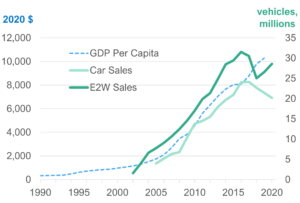World’s largest EV market facing challenges – report
Among the reasons for the decline, IDTechEx points out that the rise of the passenger car, the ultimate mobility preference as consumer purchasing power has increased, is the most important one.

But China’s reliance on lead-acid batteries has also played a role in the decline because up to 80% of toxic waste from such devices from the electric vehicle market was unaccounted for until 2019 when the government brought in a new standard. This led electric two-wheelers to both close loopholes compromising safety and transition away from lead-acid batteries.
As a side note, IDTechEx mentions that the share of Li-ion batteries in two-wheelers has been increasing from 1% in 2010 to close to 20% in 2020, a trend that its experts expect to continue to at least 50% in 2025 as Li-ion production increases and costs fall.
“Moreover, an interesting mix of chemistries is helping to facilitate this transition. The usual suspects – lithium-iron-phosphate (LFP) and lithium-nickel-manganese-cobalt oxide (NMC) – are supplied, but unlike any other electric vehicle market, variants of lithium-manganese oxide (LMO), which have a good balance of performance and cost, play a large role,” the document notes.
Going back to the market decline, IDTechEx mentions that the final reason that explains the trend is the ban on electric bikes imposed by some tier-1 cities after riders started illegally disconnecting motor controllers to be able to reach speeds of up to 40kmph with two-wheelers weighing over 70 kilograms, which were legally considered bicycles.
“Since the market’s origins, China’s regulation has limited electric two-wheeler speeds, but in practice, this was not enforced,” the report reads. “The result was a massive wave of safety incidents and fatalities.” Such incidents prompted new regulations that brought in measures for motor controller tamper resistance.




